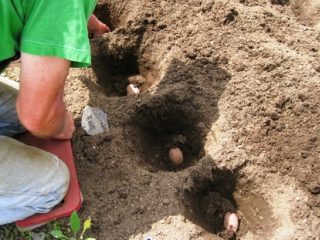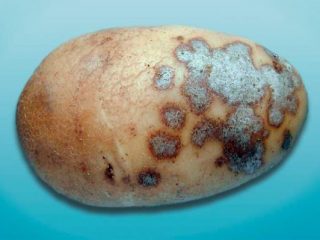Content
The Krepysh potato appeared relatively recently, but many gardeners have already been able to appreciate it. After all, this variety is able to easily adapt to different climatic conditions and at the same time show stable yields. They also speak positively about the taste of this potato. However, for successful cultivation, you need to familiarize yourself with its strengths and weaknesses in advance, as well as study its characteristics.

Potatoes are suitable for mechanical harvesting
History of appearance
Work on breeding this type of crop was carried out by specialists from the State Scientific Institution All-Russian Research Institute of Potato Farming named after. A. G. Lorkha. The basis for it was the Shurminsky-2 variety, hybrid 2953−34. And, judging by the stated characteristics, he managed to absorb the best qualities of his ancestors.
And in 2005, the Krepysh potato was included in the State Register after successfully conducted tests.
Description of seed potatoes of the Krepysh variety
The variety has some features in the appearance of bushes and tubers. Thanks to this, it stands out from other types of culture.
Bush
Potato Krepysh forms medium-sized or tall bushes of an intermediate type, 60-65 cm high. Its stems are erect at the initial stage of growth, and subsequently slightly bend to the sides. The leaves are medium in size, about 9-10 cm long. Their color is green, but sometimes becomes darker. There is moderate to strong waviness along the edge of the plates. Veins are not visible on the surface. The shoots are densely leafy at the top and bare at the bottom.
Flowering is long lasting. The corollas are large, up to 1 cm in diameter, red in color with a purple tint. The anthocyanin color on the inside is absent or barely noticeable. Inflorescences consist of 8-9 buds.

The Krepysh potato blooms in the third ten days of June when planted in mid-May
Tubers
The root system of this type of crop is quite well developed. Under one bush, 7-13 tubers are formed, the average weight of which is 78-105 g. However, individual specimens can grow much larger. Krepysh's tubers are oval, uniformly yellow in color. The peel is smooth and transparent. When cut, you can see the cream-colored flesh with a dense consistency. The ocelli lie at an average depth or may be superficial.

The pulp of Krepysha tubers does not darken when in contact with air
Characteristics of Krepysh potatoes
Only by studying the characteristics of potatoes of this variety can you get an idea of its productivity. This information will also allow you to find out its resistance to diseases.
Taste qualities of Krepysh potatoes
Judging by the reviews, Krepysh potatoes have a high taste, which has contributed to the growth of its popularity. During the cooking process, the pulp retains its consistency and does not become watery; it softens slightly. The starch content in tubers is 10-12.1%.
The fortress can be used for:
- first courses;
- salads;
- vegetable mixtures;
- boiling in its purified form and “uniform”;
- frying
This variety is also recommended for making French fries, chips and semi-finished products that require freezing.
Ripening time for Krepysh potatoes
This variety belongs to the early ripening category. The duration of the growing season from the moment the sprouts appear is a little more than two months. However, when growing strong bushes to get an early harvest, you can dig up the bushes on the 45th day.
Productivity
Tests have shown that the yield of Krepysha exceeds the Zhukovsky early variety by 84 c/ha and amounts to 127-242 c/ha, depending on the timing of fruit harvest. At the same time, the yield of marketable tubers is about 86-99%. This indicator directly depends on weather conditions during the season and the correctness of fertilizing.
Growing regions
The Krepysh variety is recommended for cultivation in five regions of the country: Central, Northern, Central Black Earth, Northwestern, Far Eastern. But since Krepysh is characterized by rapid adaptation to different climatic conditions, it is suitable for cultivation throughout Russia, which is confirmed by reviews of experienced gardeners.
Disease resistance
According to the characteristics and description of the variety, the Krepysh potato is invulnerable to cancer, golden cyst nematode, scab, and viral infections. However, this species is susceptible to late blight. Therefore, it is necessary to carry out preventive treatments of bushes in case of prolonged rainy weather.
Advantages and disadvantages
The Krepysh potato has a lot of advantages, which explains its popularity among gardeners. But there are also certain disadvantages that need to be taken into account.

The keeping quality level of the Krepysh crop is 97%
Main advantages:
- stable yield;
- excellent taste properties;
- undemanding to the composition of the soil;
- quick adaptation to any climatic conditions;
- precocity;
- possibility of early collection;
- versatility of application;
- tolerates long-term storage and transportation;
- high yield of marketable tubers;
- does not suffer from drought;
- Suitable for mechanical collection.
Flaws:
- has no immunity to late blight;
- needs frequent hilling;
- susceptible to the Colorado potato beetle;
- demanding of fertilizing.
Landing rules
Potatoes Strong need to be planted in early May. But if weather conditions are not conducive to this, then it is necessary to postpone the procedure for 1-2 weeks, since the tubers will not be able to fully develop in cold soil.
Experts recommend pre-germinating planting material. To do this, the tubers need to be brought into a room with a temperature of +15 C 20 days before planting and spread out in one layer. The potatoes need to be turned periodically to ensure even sprouting.
Due to the short growing season, for the full development of Krepysh bushes, soil rich in organic matter is required. Site preparation should begin in the fall.During this period, it is recommended to dig up the bed and add humus or fresh manure at the rate of 10 kg per 1 sq. m. m. With the arrival of spring, it is recommended to repeat loosening the soil, which will improve its aeration.

You can plant Krepysh potatoes when the soil warms up to +8 °C
The best option for this variety is loam and sandy loam soil with good moisture and air permeability. It is also possible to plant Krepysh potatoes in heavy soil if you first add not only organic matter, but also sand at the rate of 10 kg per 1 sq. m. m.
The optimal depth for planting tubers is 10 cm. It is recommended to make holes at a distance of 35 cm, and maintain 65 cm between rows.
When growing Krepysh potatoes, crop rotation must be observed. The best precursors for the crop can be carrots, legumes, cabbage, and meadow grasses.
How to care
This variety is characterized by increased resistance to drought. Therefore, Krepysh potatoes need to be watered only in case of prolonged drought. Moistening should be carried out in the evening, soaking the soil to a depth of 10 cm.
Ten days after planting, it is recommended to carry out the first loosening of the soil to a depth of 2 cm. This is necessary to maintain air access to the tubers. In the future, it is necessary to do weeding several times as the weeds grow.
When the shoots reach a height of 10 cm, you need to carry out the first hilling of the bushes. In the future, the procedure should be done at the stage of stem height of 25 cm. It is also recommended for Krepysh to do the third hilling during the period of closure of the bushes. This significantly increases the yield of the variety.
The robust potato responds well to fertilizing; it must be carried out taking into account the development of the potato. During the period of active growth of shoots and leaves, it is recommended to use ammonium nitrate at the rate of 30 g per 10 liters of water. At the stage of formation of flower stalks, you need to use nitroammophoska in the same proportion, and after flowering, superphosphate 30 g and potassium sulfide 25 g per bucket of water.
Harvest and storage
At the end of July, at the beginning of June, the Krepysha bushes begin to fade. When the shoots are completely dry, harvesting can be done. It is recommended to dig up potatoes in dry weather, and then leave the crop in the garden for two hours and only then move it indoors. It is recommended to dry the tubers for three weeks, which guarantees their long-term preservation in the future. And then the harvest can be transferred to the basement. Optimal storage conditions: temperature +4 °C and humidity 85%.

The Krepysh variety lasts well until the new harvest.
Conclusion
Krepysh potato is a promising early crop variety with excellent taste. And, despite the fact that in terms of productivity it may be inferior to other types of crops, this is fully compensated by the quality of the fruits and the high level of shelf life. This explains the growing popularity of this variety.
Reviews from gardeners about Krepysh potatoes








